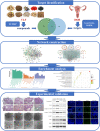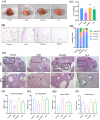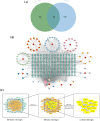Investigation of the Mechanisms and Experimental Verification of Yulin Formula in the Treatment of Diminished Ovarian Reserve via Network Pharmacology
- PMID: 37521037
- PMCID: PMC10377651
- DOI: 10.2147/DDDT.S413142
Investigation of the Mechanisms and Experimental Verification of Yulin Formula in the Treatment of Diminished Ovarian Reserve via Network Pharmacology
Abstract
Purpose: The aim of this study is to examine, using network pharmacology analysis and experimental validation, the pharmacological processes by which Yulin Formula (YLF) reduces cyclophosphamide-induced diminished ovarian reserve (DOR).
Methods: First, information about the active components, associated targets, and related genes of YLF and DOR was gathered from open-access databases. The primary targets and pathways of YLF to reduce DOR were predicted using studies of functional enrichment from the Kyoto Encyclopedia of Genes and Genomes (KEGG), Gene Ontology (GO), and Protein-Protein Interaction (PPI) networks. Second, we built a cyclophosphamide-induced diminished ovarian reserve (DOR) rat model to verify the primary target proteins implicated in the predicted signaling pathway to explore the mechanism of improve ovarian function of YLF.
Results: 98 targets met the targets of the 82 active ingredients in YLF and DOR after searching the intersection of the active ingredient targets and DOR targets. Fourteen targets, including AKT and Caspase-3 among others, were hub targets, according to the PPI network study. The PI3K/AKT pathway was revealed to be enriched by numerous targets by the GO and KEGG enrichment studies, and it was used as a target for in vivo validation. Animal studies showed that YLF administration not only reduced the number of atretic follicles, the proportion of TUNEL-positive ovarian cells, the rate of apoptosis of granulosa cells (GCs) and the proportion of abnormal mitochondria in DOR rats, but also reversed the high expression of Caspase-3, Caspase-9, BAX, cytochrome C, PI3K and P-AKT, improving the ovarian reserve in cyclophosphamide (CTX)-induced DOR rats.
Conclusion: Our research results predicted the active ingredients and potential targets of YLF-interfering DOR by an integrated network pharmacology approach, and experimentally validated some key target proteins participated in the predicted signaling pathway. A more comprehensive understanding of the pharmacological mechanism of YLF for DOR treatment was obtained.
Keywords: PI3K/AKT; Yulin Formula; apoptosis; diminished ovarian reserve; network pharmacology; pharmacological mechanisms.
© 2023 Wang et al.
Conflict of interest statement
The authors declare that they have no competing interests in this work.
Figures







Similar articles
-
The role of Chinese herbal medicine in diminished ovarian reserve management.J Ovarian Res. 2025 Apr 30;18(1):90. doi: 10.1186/s13048-025-01669-4. J Ovarian Res. 2025. PMID: 40307895 Free PMC article. Review.
-
Study on the effects and mechanisms of Wenzhong Bushen Formula in improving ovarian reserve decline in mice based on network pharmacology.J Ethnopharmacol. 2024 Apr 24;324:117756. doi: 10.1016/j.jep.2024.117756. Epub 2024 Jan 12. J Ethnopharmacol. 2024. PMID: 38218503
-
Network pharmacology and experimental validation on yangjing zhongyu decoction against diminished ovarian reserve.J Ethnopharmacol. 2024 Jan 10;318(Pt B):117023. doi: 10.1016/j.jep.2023.117023. Epub 2023 Aug 9. J Ethnopharmacol. 2024. PMID: 37567422
-
The Network Pharmacology Analysis of Tonifying Yang Formula for the Treatment of Diminished Ovarian Reserve.Altern Ther Health Med. 2024 Mar;30(3):176-184. Altern Ther Health Med. 2024. PMID: 37883761
-
Preventing chemotherapy-induced ovarian damage through PI3K/AKT and Hippo pathway regulation.Support Care Cancer. 2025 Mar 28;33(4):328. doi: 10.1007/s00520-025-09344-6. Support Care Cancer. 2025. PMID: 40153062 Review.
Cited by
-
The role of Chinese herbal medicine in diminished ovarian reserve management.J Ovarian Res. 2025 Apr 30;18(1):90. doi: 10.1186/s13048-025-01669-4. J Ovarian Res. 2025. PMID: 40307895 Free PMC article. Review.
-
Mechanisms of He Shi Yu Lin formula in treating premature ovarian insufficiency: insights from network pharmacology and animal experiments.J Ovarian Res. 2024 Dec 27;17(1):254. doi: 10.1186/s13048-024-01575-1. J Ovarian Res. 2024. PMID: 39731132 Free PMC article.
References
MeSH terms
Substances
LinkOut - more resources
Full Text Sources
Medical
Research Materials
Miscellaneous

